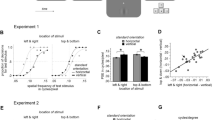Abstract
We have investigated the discriminability of gratings which simultaneously vary in spatial frequency and orientation. Thirteen and nine reference gratings were used with two observers, and bivariate discrimination probability surfaces were determined around each grating. These data were then fitted to a general bivariate Gaussian function. The results clearly demonstrate local separability in this log frequency and orientation discrimination domain. Our results also show that the factor contributing most to the non-Euclidean nature of such frequency/orientation discrimination is orientation anisotropia, although we also find some evidence for smaller changes in the associated Riemannian line-element at different frequency ranges. These results cast doubt upon claims for a “pseudo line-element” for frequency discrimination based upon the nonlinear outputs of a fixed set of detectors.
Similar content being viewed by others
References
Appelle S (1972) Perception and discrimination as a function of stimulus orientation: the oblique effect in man and animais. Psychol Bull 78:226–278
Caelli TM, Hübner M (1983) On the efficient two-dimensional energy coding characteristics of spatial vision. Vision Res 23:1053–1055
Caelli TM, Moraglia G (1985) On the detection of Gabor signals and the discrimination of Gabor textures. Vision Res 25:671–684
Caelli T, Rentschier I (1986) Cross-correlation model of pattern acuity. J Opt Soc Am A 3:1948–1956
Caelli TM, Brettel H, Rentschier I, Hilz R (1983) Discrimination thresholds in the two-dimensional spatial frequency domain. Vision Res 23:129–133
Campbell FW, Nachmias J, Jukes J (1970) Spatial frequency discrimination in human vision. J Opt Soc Am 60:555–559
Daugman J (1980) Two-dimensional spectral analysis of cortical receptive field profiles. Vision Res 20:847–856
Daugman J (1983) Six formal properties of two-dimensional anisotropic visual filters: Structural principles and frequency/orientation selectivity. IEEE Trans SMC-13:882–887
Daugman J (1984) Spatial visual channels in the fourier plane. Vision Res 24:891–910
DeValois R, DeValois K (1980) Spatial vision. Ann Rev Psychol 31:309–341
Dorfman DD, Alf E Jr (1969) Maximum likelihood estimation of parameters of signal-detection theory and determination of confintervals-rating method data. J Math Psychol 6:487–496
Ferraro M, Caelli TM (1988) Relationships between integral transforms invariance and lie group theory. J Opt Soc Am A 5:738–742
Green DM, Swets JA (1974) Signal detection theory and psychophysics. Krieger, New York
Heeley DW, Patterson IR, Thompson RJ (1987) Size discrimination thresholds for spatially localised patterns. Perception 16:229
Hirsch J, Hylton R (1982) Limits of spatial-frequency discrimination as evidence of neural interpolation. J Opt Soc Am 72:1367–1374
Hsu YN, Arsenault HH, April G (1982) Rotation-invariantdigital pattern recognition using circular harmonic expansion. Appl Opt 12:4012–4015
Korn G, Korn T (1968) Mathematical handbook for scientists and engineers. McGraw-Hill, New York
Krantz D, Luce R, Suppes P, Tversky A (1971) Foundations of measurement, vol 1. Academic Press, New York
MacAdam DL (1942) Visual sensitivities to color differences in daylight. J Opt Soc Am 32:247
MacAdam DL (1943) Specification of small chromaticity differences. J Opt Soc Am 33:18–26
Mayer JM, Kim CBY (1986) Smooth frequency discrimination functions for foveal, high-contrast, mid spatial frequencies. J Opt Soc Am A 3:1957–1969
Sachs L (1984) Angewandte Statistik. Springer, Berlin Heidelberg New York, pp 329–332
Silberstein L (1943) Investigations on the intrinsic properties of the color domain. J Opt Soc Am 33:1–10
Silberstein L, MacAdam DL (1945) The distribution of color matchings around a color center. J Opt Soc Am 35:1
Treutwein B, Caelli TM, Rentschier I (1983) Visual sensitivities to two-dimensional frequency differences. Perception 12:A86
Wilson HR, Gelb DJ (1984) Modified line-element theory for spatial-frequency and width discrimination. J Opt Soc Am A 1:124–131
Wilson HR, Regan D (1984) Spatial-frequency adaptation and grating discrimination: predictions of a line-element model. J Opt Soc Am A 1:1091–1096
Author information
Authors and Affiliations
Additional information
Study supported by Fraunhofer Gesellschaft Grant INSAN I 0784-V-6385 and Guest Professorship Mu 93/103-1 for TC by Deutsche Forschungsgemeinschaft
Rights and permissions
About this article
Cite this article
Treutwein, B., Rentschler, I. & Caelli, T. Perceptual spatial frequency — Orientation surface: Psychophysics and line element theory. Biol. Cybern. 60, 285–295 (1989). https://doi.org/10.1007/BF00204126
Received:
Issue Date:
DOI: https://doi.org/10.1007/BF00204126




